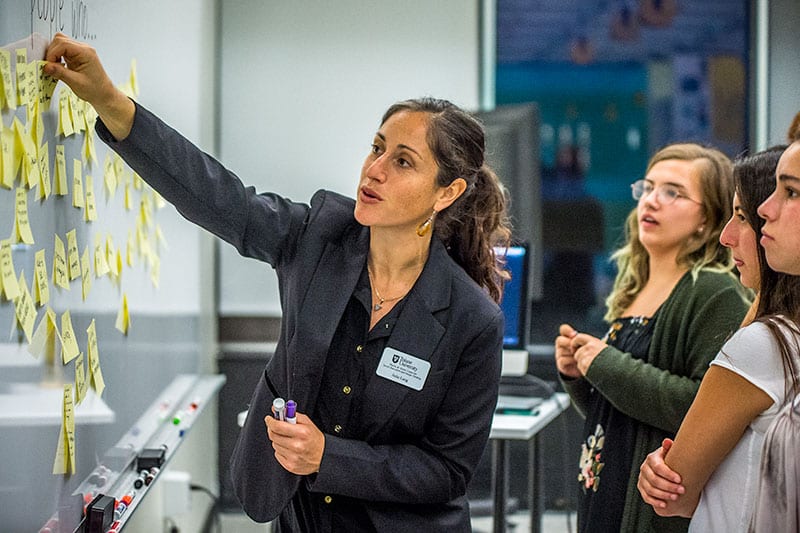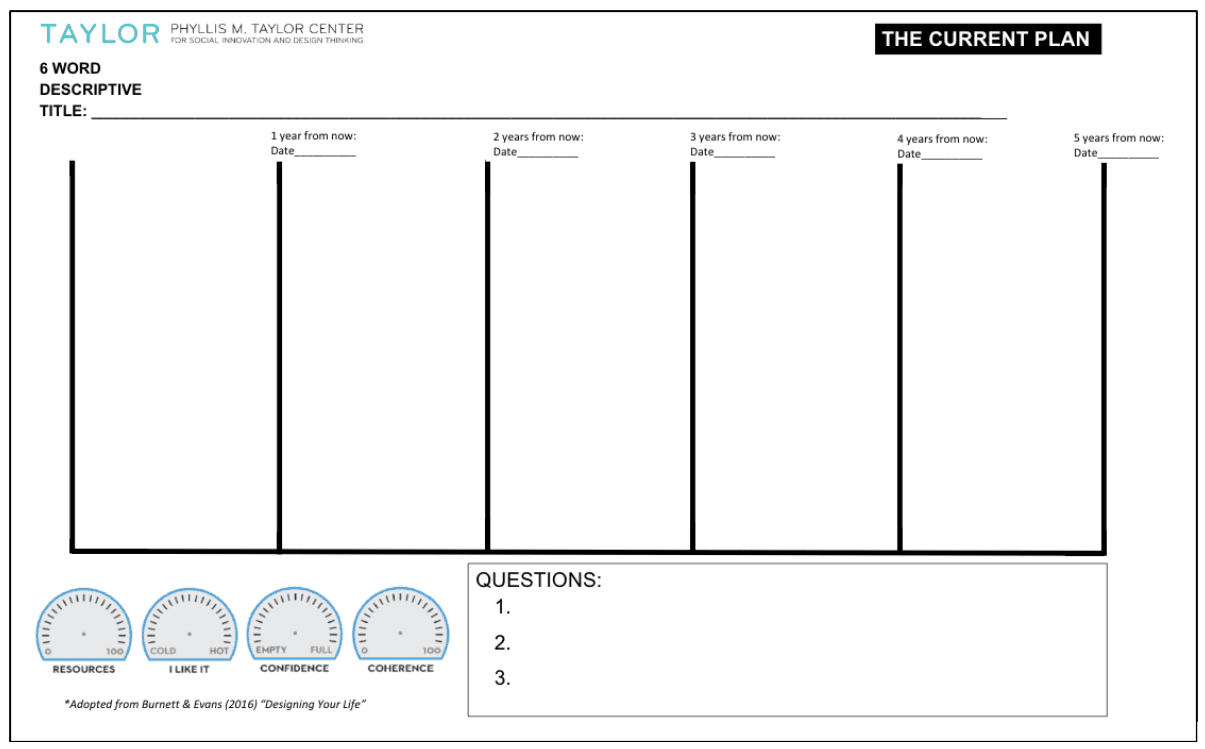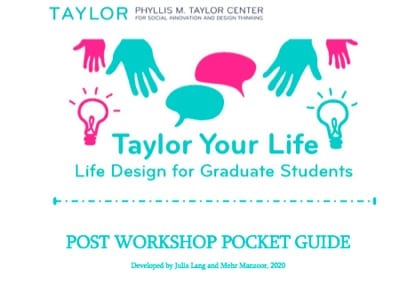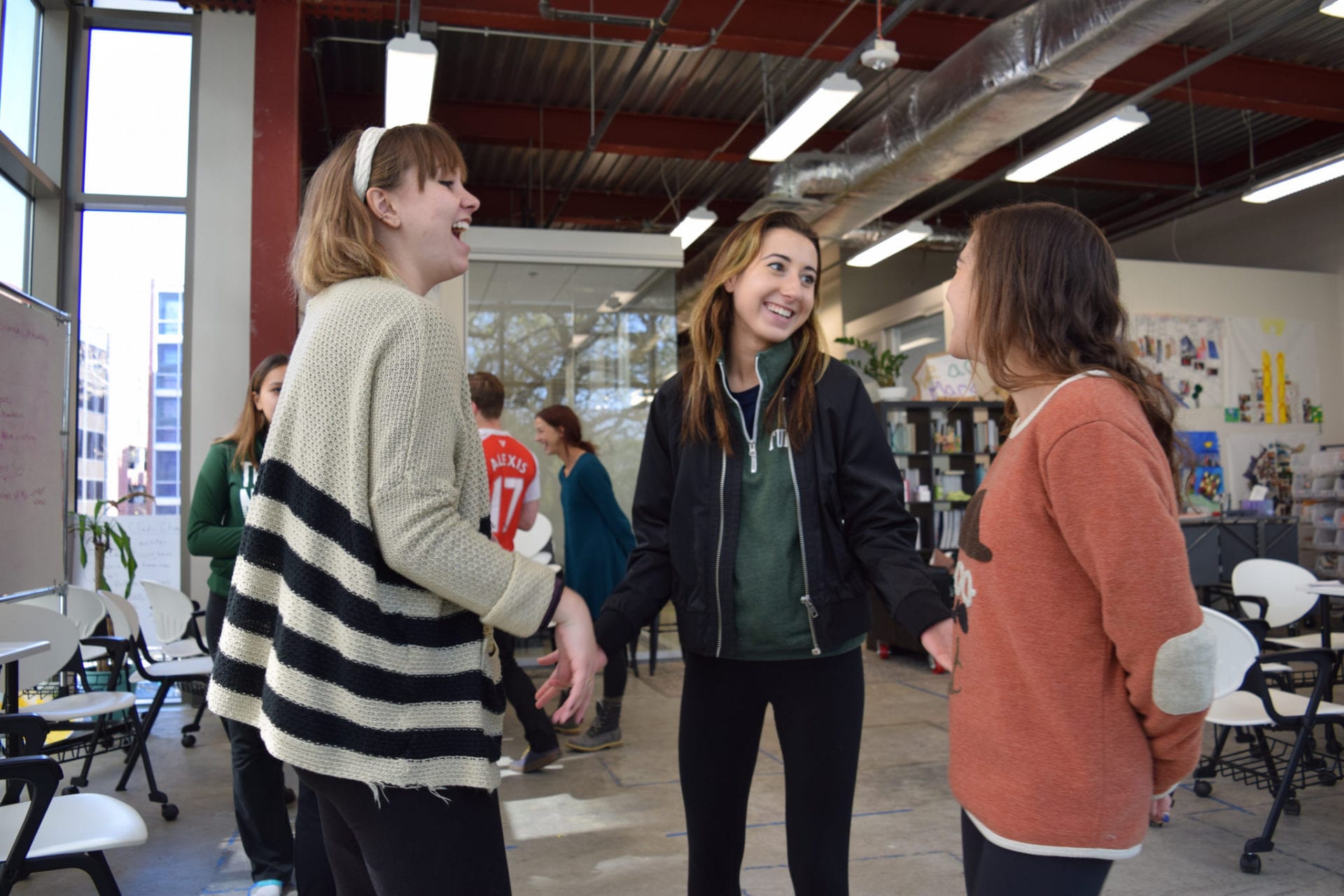Session 1: Pre-Work
Before our Session 1, be sure to:
- Call or text at five people you know and ask them about your strengths. Bring the compiled responses to our session.
- Read the Introduction through Ch. 4 of Designing Your Life.
Optional Bonus Activities
Below are some optional bonus activities. Each one is explained in the attached reading. This is not required, but strongly encouraged. You are carving out this time for yourselves to design the next chapter of your lives- take advantage of this time.
- Complete Health/Work/Play Dashboard (Ch 1: Designing Your Life)
- Write out Workview and Worldview (Ch 2: Designing Your Life)
- Complete Good Times Journal (start now so you have a week to complete daily logs before our first session) (Ch 3: Designing Your Life)
- Mindmapping (complete after you have done the Good Times Journal above) (Ch 4: Designing Your Life)
Session 2: Pre-Work
Before our Session 2, be sure to:
- Read “Odyssey Planning 101”
- Read Ch 6. “Prototyping” from Designing Your Life book
- Watch Multipotentiality video
Optional Bonus Activities
Below are some optional bonus activities that are strongly encouraged. You are carving out this time for yourselves to design the next chapter of your lives- take advantage of this time.
- Create Fearless Mission Statements
- For more information on Odyssey Planning read Ch. 5 “Odyssey Planning” from Designing Your Life book
Session 3: Pre-Work
Before our Session 3, be sure to:
- Tweak/change Odyssey Plans as needed
- If you tried saying your Odyssey Plans out loud, but you did not like how they sounded/you are no longer excited about some paths, change them!
- Complete Prototyping Priorities worksheet from Odyssey Plans
- Complete Prototyping Priorities handout OR create a timeline/action plan for gaining new skills and experiences relevant to your job search/career goals
- What are prototype conversations that could help you answer questions (with whom could you speak that is doing/involved with this sort of work that might be able to offer insight into the field/job?)
- What are prototype experiences that might help you answer questions (how can you test out what this path might be like?)
- Complete Prototyping Priorities handout OR create a timeline/action plan for gaining new skills and experiences relevant to your job search/career goals
- Read the 5-point email tips for Life Design Interviews
- Read Ch 10. “Failure Immunity”
Session 4: Pre-Work
Before our Session 4, be sure to:
Complete one prototype:
Life Design Interviews for Graduates Directions: Complete one Life Design Interview by our next session. You may find people to connect via LinkedIn, Tulane Connect, or a contact through a friend, parent, teacher, etc.
Strongly Encouraged but optional additional design challenges
- LinkedIn Plus
-
- Career Surrogates: Identify three people doing the sort of work you want to do on LinkedIn.
-
-
- Consider: how did they get to where they are today? What is their competitive advantage?
- Look at their LinkedIn profiles and subscribe to their blogs and tweets.
- Track their professional evolution and take inspiration and insight from their journeys.
- In your sketchbook, provide 3 bullet points noting the name, position, and brief notes about their professional journey.
-
-
- Target Organizations: Identify 10-15 target organizations and look for relevant contacts in their network.
-
-
- “Like” organizations on social media, sign up for their newsletters to stay informed about opportunities and conversations in the field
- Consider reaching out to someone from a target organization for a life design interview (find them on LinkedIn, send them a professional email)
-
Session 5: Pre-Work
Before our Session 5, be sure to:
- Read Ch. 7 “How Not to Get a Job”, Ch. 8 “Designing Your Dream Job” and Ch. 9 “Choosing Happiness” (from Designing Your Life book)
- Complete prototype #2 + 3 below (strongly encourage you to do at least one prototype from each of your Odyssey plan!)
Have you spent any time looking at actual job descriptions/fellowships in your field? If not, we strongly encourage you to do this assignment.
Research jobs/fellowships that interest you.
Look at the “preferred” and “required” skills listed in each job description. What do you NOT yet have? List main skills you are missing and underneath, provide a bullet point action plan with an estimated timeline for when and how you plan to gain those skills (ie: By June 1: I will enroll in an online course on graphic design)
-
- Consider transferrable skills such as writing skills, general management experience, technical and computer skills, people smarts, and international experience or language skills
- Items can include joining a student organization, seeking out a leadership position on campus, signing up for a course or conference, or simply pledging to spend one hour each week on self-learning
Places to look for job descriptions:
- Handshake (Tulane’s portal for jobs, internships, and fellowships. Log in and customize your profile to get job alerts geared in your field. Over 1200 active employers are on the platform currently. For instructions on how to log in, click here ).
- World’s Top Meta List for Jobs in Social Change
- PCDN (clearinghouse for thousands of changemaking jobs)
- Places to look for changemaking jobs.
- Consider looking at fellowships (ProFellow.)
- Idealist.org.
- 17 websites to know for jobs in social enterprise/non-profit sector.
- 34 Places to Find That New Job: Social Innovation Edition
Additional Resources
Read Tailoring your Profile to your Goals. Your profile should include:
- Active links (link to all previous employers and add links to artifacts of prior academic and co-curricular activities)
- Recommendations from peers, former employees, internship supervisor, and professors. Click here for instructions on asking for recommendations in LinkedIn.
- A concise and unique profile summary: This is a core piece of LinkedIn- your profile MUST have a profile summary that briefly shares about you. In TYL, we have students develop a “pitch”, which can then be converted into a profile summary. Click here for a tip sheet on developing that pitch.
- Strong bullet points: Each experience should have bullet points. Reference building better bullet points
- Skills: Endorse your “friends” and ask for others to do the same for you
- Professional and relevant photos: This should be a professional photo. Consider your main photo and the backdrop (it should be aligned with your professional target community. For instance, if you want to be a teacher, show pencils/materials in the back; if you want to be an architect, your backdrop could be a building you admire)
- Contacts (try for at least 300, the suggested amount is 500) Consider this list of contacts.
- Add them on LinkedIn, if they are on the platform
- Consider if this is a person you can ask for a recommendation on LinkedIn
For Reference: To network and find contacts on LinkedIn:
- Enter “Tulane University” and select “Find Alumni”
- Use the search bar to explore alumni based on keywords that interest you (for example: education, social innovation, public health, etc.). note: you can adjust graduation years if you want to search for an older or younger alumni.
- Click the arrow on the far right of the screen to toggle to the screen where you can mark first or second-degree connections, as well as view other categories.
- You will see bars generated with “where they live, “where they work,” etc.
- If you are a second level connection, reach out to the person that connects you via email and ask for an introduction, briefly explaining your intention/interest in their work.
- Follow up with a personalized thank you note
Strongly Encouraged but optional additional design challenges
- Salary Negotiation workbook and creating a budget
- Explore the Salary Negotiation Workbook and create a budget and/or compare costs between cities where you might live
- I encourage you to read the workbook in full, but please pay particular attention to pages 4-14 (complete the activity on pg 13/14),18-20 and 25-26.
- Complete the budget exercise (pgs 16-17).
- Alternatively, create an abbreviated version by exploring these websites:
- Budget
- Compare costs between several cities you are considering living in:
- Explore the Salary Negotiation Workbook and create a budget and/or compare costs between cities where you might live
- Continue to ideate:
- Ideating: Job Exploration
- Social Issues and Professional Pathways
- Write down the top 5 issues in the world that you care about (ex: damage to coral reefs, depiction of latinos in the media, systemic racism, decay of public schools, poetry and art)
- For each one, make a list of at least 5-10 jobs that would allow you to contribute to that issue
- Under each job, write down aspects of that job that you like (ie: public speaking, teaching, financial management, etc.)
- Finally, make a list of 5-10 other jobs that have those aspects
- Social Issues and Professional Pathways
- Ideating: Job Exploration
Session 5: Post-Work
Design Challenges to complete:
- Complete TYL4Grads Post Survey
- We have prepared a TYL4Grads pocket guide as a resource guide for you to help you in your life design journey.
TAYLORing Your Life: Post-Workshop
Strongly Encouraged but optional additional design challenges
- Ch 11 “Building a Team” and “Conclusion”
- Read “All the best advice we could find on how to get A job”
- Read: Christensen, “How Will You Measure Your Life?“
- Watch Dan Ariely TED talk – What makes us feel good about our work?
- Read: Bock, “The Biggest Mistakes I See on Resumes…”
- Read: Bock, “My Personal Formula for a Winning Resume“
- Read: Altucher, “How to Persuade Anyone of Anything in Ten Seconds“
- Read: Krakovsky, “Researchers: If you want a favor, ask and ask again”
- Read “How to evaluate, manage and strengthen your resilience” by Dave Kopans
ONLINE CAREER RESOURCES for GRAD STUDENTS and POSTDOCS
- Handshake is a career service management and networking system that Tulane uses to coordinate events, connect recruiting employers and students, and advertise jobs, resources, and news.
- Carpe Careers is a weekly career advice column for graduate students in Inside Higher Ed and is authored by members of the Graduate Career Consortium.
- National Center for Faculty Development and Diversity is an independent organization dedicated to supporting faculty, particularly under-represented faculty, post-docs, and graduate students in making successful transitions throughout their careers; Tulane is a subscribing member.
- Versatile PhD is a terrific online resource for PhDs seeking careers outside of academia; Tulane is a subscribing institution.
- Imagine PhD is a free, online career assessment, exploration, and planning tool for PhDs in the humanities and social sciences.
- myIDP is a free, online career assessment, exploration, and planning tool for PhDs in STEM fields.
- Beyond the Professoriate is a company with resources (some free, some for paid members) for PhD students who are exploring diverse career paths.
RESOURCES FOR JOB SEARCH:
- World’s Top Meta List for Jobs in Social Change
- PCDN (a clearinghouse for thousands of changemaking jobs)
- Places to look for changemaking jobs.
- Consider looking at fellowships (ProFellow.)
- Idealist.org.
- 17 websites to know for jobs in a social enterprise/non-profit sector.
- 34 Places to Find That New Job: Social Innovation Edition
Additional Resources

Want to Learn More?
- Interested in a collaboration or discussing life design?
- Email Julia Lang at jlang@tulane.edu.


